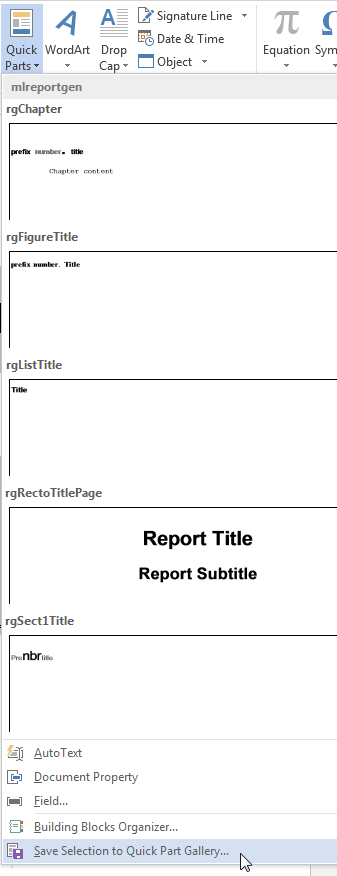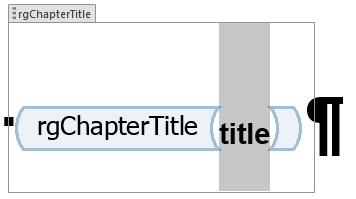自定义 Microsoft Word 组件模板
自定义 Word 组件模板
您可以自定义 Word 组件模板(例如标题页模板)以:
自定义报告格式以满足您的特定格式要求。
通过删除空位来删除内容。有关空位的描述,请参阅组件空位。
通过改变空位的顺序来改变组件布局。
更改标题页、目录或章节页面布局,包括页面大小、页面方向、页边距以及页眉和页脚的内容和格式。
如果删除组件模板中的空位,则生成的报告将不包含与该空位关联的组件数据。例如,rgRectoTitlePage 部件模板包含 rgAuthor 空位。如果删除 rgAuthor 空位,则使用模板生成的报告将不包含作者,即使报告具有为 Author 属性指定值的标题页面组件。
报告资源管理器将忽略组件模板中与组件指定的内容属性不对应的空位。如果您需要生成报告资源管理器的某个组件未解决的内容,请使用形式或子表单组件来生成内容。例如,您可以使用带有自定义模板的子表单组件来生成包含标题页面组件未涉及的内容(例如签名模块)的标题页。
在 Word 中显示开发人员功能区
要处理 Word 模板中的空位,请使用 Word 开发工具工具栏。如果开发工具选项卡未显示在 Word 工具栏中,请将其添加到工具栏。
在 Word 中,选择 文件 > 选项。
在 Word 选项对话框中,选择自定义功能区。
在自定义功能区列表中,选中开发工具复选框并点击确定。
提示
如果在列表中没有看到开发工具复选框,请将自定义功能区设置为主选项卡。
自定义 Word 组件模板
要自定义报告元素(如标题页),请用模板的自定义副本替换相应的默认组件模板。有关创建自定义 Word 组件模板的示例,请参阅 自定义 Microsoft Word 标题页模板。
注意
您不能直接自定义默认模板的样式。您必须创建默认模板的副本并自定义副本的样式,请参阅复制模板。
在报告资源管理器中,选择工具 > 编辑文档转换和模板。
在中间窗格的模板列表中,选择一个自定义模板。
注意
如果模板没有出现在模板列表中,请刷新报告资源管理器的模板缓存,请参阅模板缓存。
在属性窗格中,点击打开模板。
在模板的开始处,将光标定位在第一段,然后点击快速部件按钮。
在插入选项卡中,选择快速部件
 按钮。
按钮。在快速部件库中,选择部件模板(例如,rgChapter)。
编辑部件模板的副本。例如,通过右键点击并选择删除内容控制来消除一个空位。
在模板中,选择部件模板,包括其所有空位。
在快速部件库中,选择保存所选内容到快速部件库。
在“创建新的构建块”对话框中,将名称设置为部件模板名称(例如,rgChapter),将类别设置为 mlreportgen。点击确定。
在模板中,删除自定义的部件模板。
保存主模板。
设置空位的默认文本样式
您的模板可以指定一个样式的名称,作为默认样式来格式化为空位生成的文本。
在报告资源管理器中,选择工具 > 编辑文档转换和模板。
在中间窗格的模板列表中,选择包含要为其设置默认文本样式的空位的自定义模板。
在模板浏览器中,点击打开模板。
在插入选项卡中,选择快速部件
 按钮。
按钮。在快速部件库中,选择包含空位的部件模板(例如,rgChapter)。
在想要指定默认文本样式的空位的文本区域中点击鼠标右键。例如,在 rgChapter 中,右键点击
rgChapterTitle空位。
选择属性。
在内容控制属性对话框中,选中使用样式设置键入空控件中的文本格式复选框。
从样式列表中,选择一种样式以使用现有样式或选择新建样式以创建新样式作为默认样式,然后点击确定。
选择部件模板并点击快速部件按钮。
点击保存选择到快速部件库。

在“创建新的构建块”对话框中,将名称设置为部件模板名称(例如,rgChapter),将类别设置为 mlreportgen。点击确定。
保存并关闭模板。
区分内联空位和块状空位
报告资源管理器支持两种类型的空位:内联空位和模块。
使用内联空位来表示可包含在 Word 段落中的内容。
对于无法嵌入段落的内容,请使用块状空位。
您可以配置 Word 编辑器以提供视觉提示,指示某个空位是内联空位还是块状空位。
打开自定义 Word 模板。
在 Word 功能区上,选择主页选项卡。
点击显示/隐藏
 按钮可显示 Word 段落标记。
按钮可显示 Word 段落标记。在 Word 工具栏上,选择开发工具选项卡。
点击设计模式查看空位的 Word 标记。
点击一个空位来确定它是内联空位还是块状空位。
内联空位 - 边界框不包含段落标记。

块状空位 - 边界框确实包含段落标记。

避免将块状空位更改为内联空位
不要将块状空位更改为内联空位。
您可能会意外地通过删除块状空位后面跟着的内联空位的段落标记而将块状空位更改为内联空位。例如,如果删除 rgChapterTitle 内联空位的段落标记,则 rgChapterContent 块状空位将变为内联空位。

删除空位
在报告资源管理器中,选择工具 > 编辑文档转换和模板。
在中间窗格中的 Word 模板列表中,选择要编辑的自定义模板。
在模板浏览器中,点击打开模板。
要显示 Word 段落标记(如果它们尚不可见),请在 Word 功能区的主页选项卡中点击 Show/Hide
 按钮。
按钮。在 Word 功能区中的插入选项卡中,点击快速部件
 按钮。
按钮。选择要自定义的部件模板。例如,选择
rgChapter来自定义章节的部件模板。
提示
要显示部件模板的 Word 标记,请在 Word 工具栏上的开发工具选项卡中点击设计模式。
写下您正在自定义的部件模板的名称,因为您需要在此过程的后面输入该名称。
在
rgChapter部件模板中,删除rgChapterTitlePrefix空位。选择空位标记并点击删除键。在模板中,选择部件模板的所有内容。
右键点击并选择属性。
在内容控件属性对话框中,在标题和标记字段中,输入您正在自定义的模板部件的名称
rgChapter。点击确定。在模板中,选择部件模板的所有内容。在插入选项卡中,点击快速部件按钮。
点击保存选择到快速部件库。
在“创建新的构建块”对话框中,将名称设置为部件模板名称(例如,rgChapter),将类别设置为 mlreportgen。点击确定。
在模板中,选择部件模板的所有内容,然后点击删除按钮。
保存并关闭模板。
添加内联空位
在报告资源管理器中,选择工具 > 编辑文档转换和模板。
在中间窗格中的 Word 模板列表中,选择要编辑的自定义模板。
在模板浏览器中,点击打开模板。
要显示 Word 段落标记,点击显示/隐藏
 按钮。
按钮。将 Word 插入标记定位到段落中想要添加内联空位的位置。
提示
如果空位是段落中的唯一内容或位于段落末尾,请添加几个空格,并在空格之前插入空位。
点击富文本控件按钮
 。Word 在插入点处插入一个富文本控件。
。Word 在插入点处插入一个富文本控件。要查看空位标记,请在 Word 工具栏上的开发工具选项卡中点击设计模式。
在空位中点击鼠标右键,然后选择属性。
在对话框中,在标题和标记字段中输入空位的名称。使用报告资源管理器空位名称。例如,如果插入
rgChapterTitlePrefix空位,请将标题和标记字段设置为rgChapterTitlePrefix。在模板中,选择部件模板的所有内容。在插入选项卡中,点击快速部件按钮。
点击保存选择到快速部件库。
在“创建新的构建块”对话框中,将名称设置为部件模板名称(例如,rgChapter),将类别设置为 mlreportgen。点击确定。
在模板中,选择部件模板的所有内容,然后点击删除按钮。
保存并关闭模板。
添加块状空位
在 Word 文档中创建块级空位与创建内联空位基本相同。主要区别在于富文本内容控件必须包含一个(空)段落,而不是驻留在段落中。在想要创建块级空位的位置创建一个空段落。如果您位于文档末尾,请创建第二个空段落。
删除或修改章节前缀
使用默认模板的报告在章节标题中包含单词章节作为前缀。如果您不想使用前缀,您可以在创建报告之前从模板中删除。例如,如果您想使用章节以外的词进行本地化,您可以替换前缀。
打开模板。
在 Word 插入功能区中的文本区域中,点击探索快速部件按钮。
要在模板中插入要修改的部分的实例,请选择 rgChapter 快速部分。
编辑实例。您可以删除前缀空位,也可以用固定文本替换它。
确保应用于此行的样式仍然是 rgChapter。

选择已编辑的实例。然后,在插入功能区上,点击探索快速部件按钮并选择保存所选内容到快速部件库。
在对话框中,将名称设置为
rgChapter,将类别设置为mlreportgen,然后点击确定。确认您要覆盖先前的版本。保存并关闭模板。